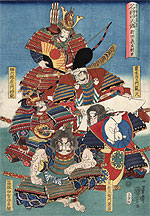 Political Chaos: the Muromachi Era 1333-1573 and Azuchi-Momoyama Era 1573-1600
Political Chaos: the Muromachi Era 1333-1573 and Azuchi-Momoyama Era 1573-1600Ashikaga Takauji deposed Emperor Go-Daigon and re-imposed a military regime, the administrative centre of this shogun government being located in Muromach, in one of Kyoto’s districts. However, the Ashikaga shoguns failed to centralise their power effectively: where legitimacy had previously resided in the imperial bloodline, the emperor’s power was now deteriorating, leading to a schism in the imperial administration, resulting in two opposing courts in Japan between 1337 and 1392, in the north and the south (nanbokuchô-jidai). Whereas the shogun could only rely on himself and his allies, in practice the country was ruled by the daimios, major landowners. The weakness of the shogun administration led to the Ônin war (1467-1477) leading to the deposition of the Ashikaga shoguns, and breaking up the central administration. Only at the end of the 16th century, with the rise of Oda Nobunaga and his general Toyotomi Hideyoshi, was the struggle resolved.


